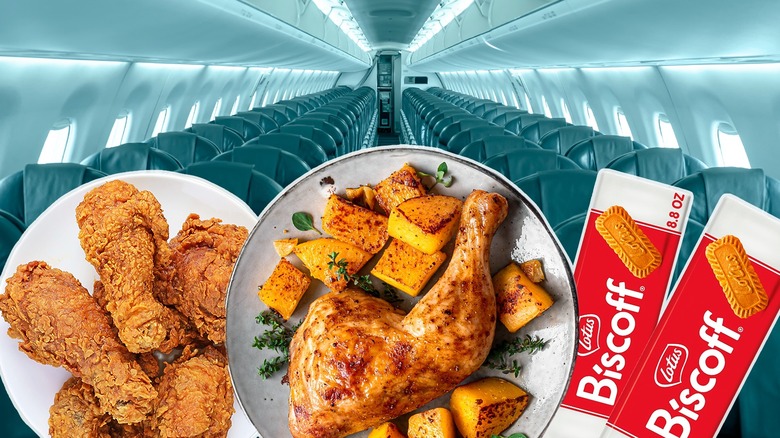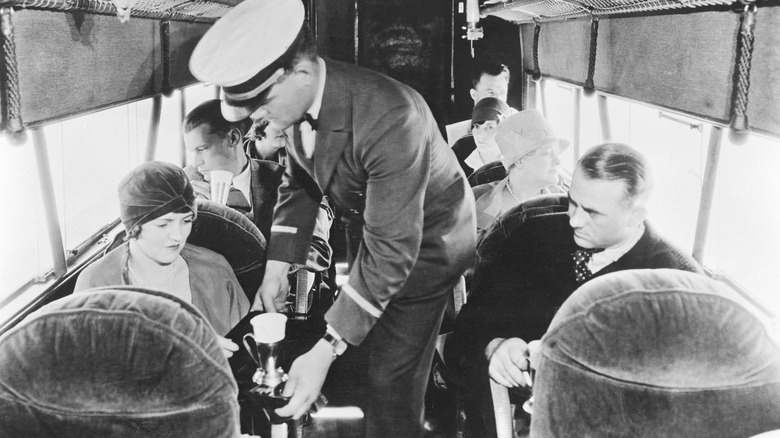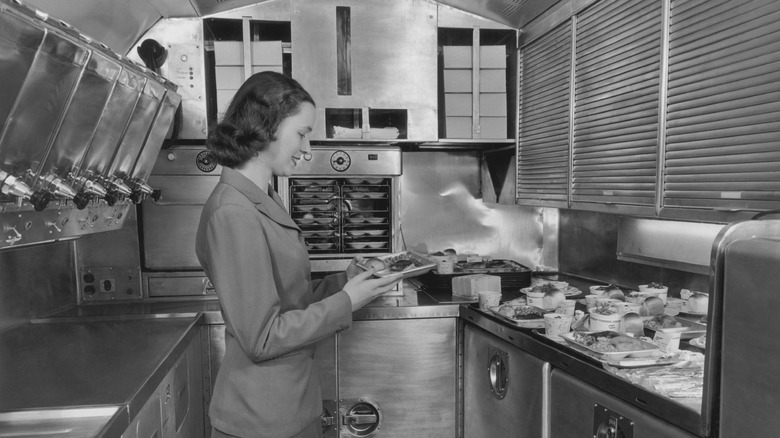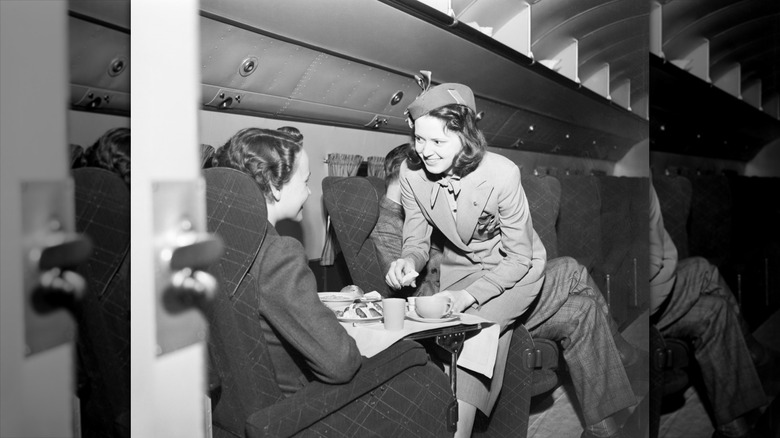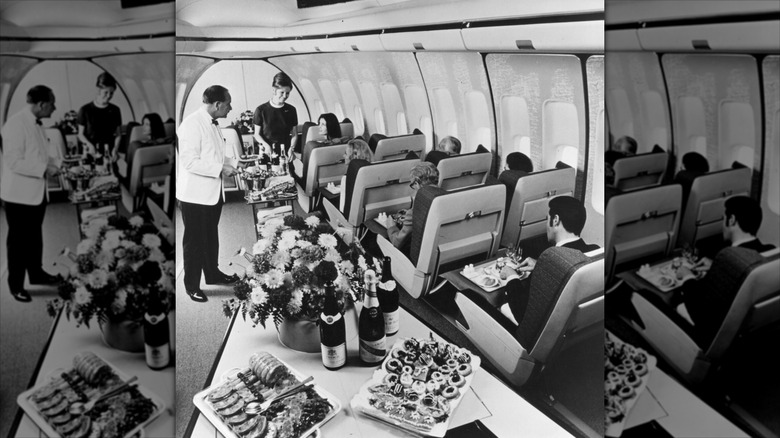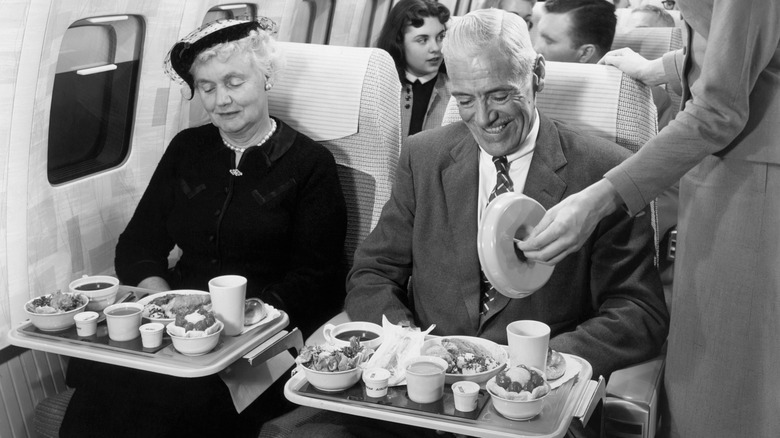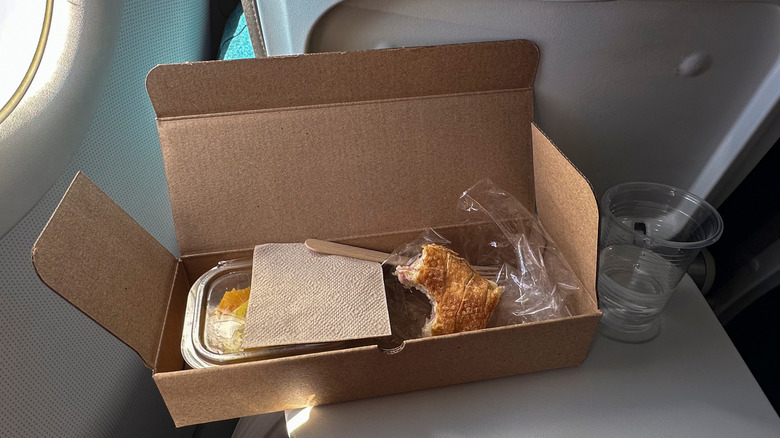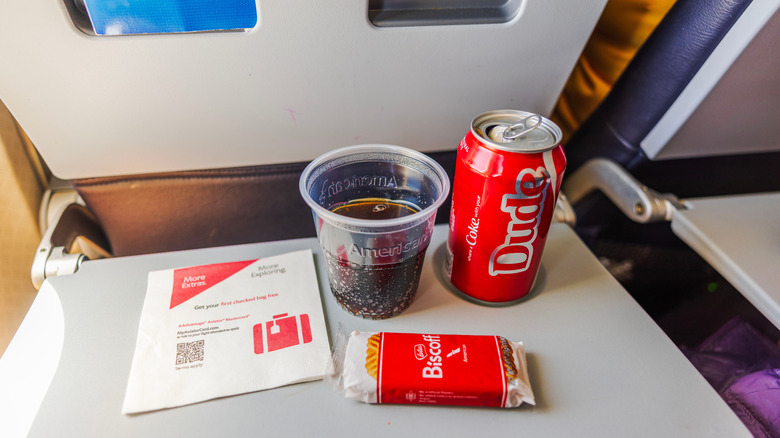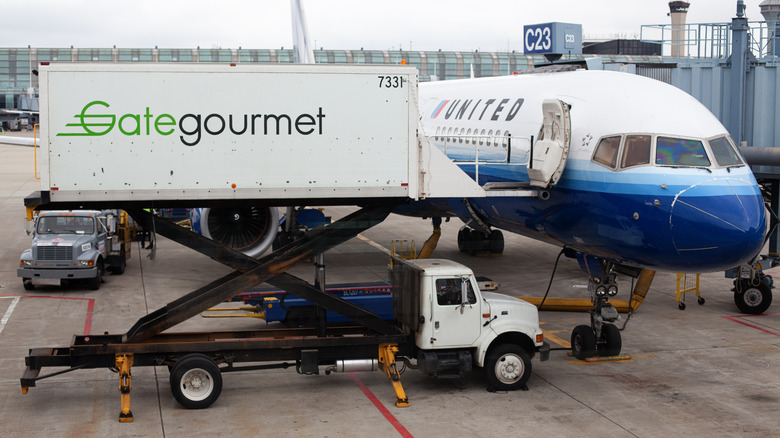The Takeoff And Descent Of Airline Dining
For the first commercial aircraft passengers, the average flight experience was extremely different from the trips we take today. For one thing, this initial era of flying was highly exclusive. Travel was not just long — it took 32 hours to fly coast to coast in the 1930s, with multiple refueling stops along the way — and super bumpy due to the low altitude, but prohibitively expensive for all except the affluent.
As air travel grew more affordable, many airlines improved their in-flight menus to accommodate a growing share of customers and as a way to distinguish their brand from competitors. Quality dining peaked during the initial era of mass travel, starting with the introduction of the Boeing 707 in the late 1950s, a time that coincided with the rise of the stylish Pan American World Airways, popularly known as Pan Am.
The decline of the glamorous jet set menus era has less to do with growing passenger traffic and more with increased price competition and corporate greed. The arc of onboard dining traverses a long journey from exceptional cuisine to meals (for most customers, at least) that have become synonymous with bad food. The journey of how we got from roast lamb to pretzels is filled with exciting stops.
Flight attendants in the 1930s served cold fried chicken
Meals were introduced on passenger planes as one of the few perks airlines could provide on long and bumpy flights. Onboard dining also served the purpose of distracting passengers who harbored a fear of flying. These meals were usually served in picnic baskets, and cold, as there was no heating unit on board. Cold fried chicken and sandwiches were the norm.
At this time, food was initially handed to passengers by a male co-pilot as they boarded the plane. These co-pilots weren't exactly thrilled to be demoted, as they saw it, from the "dignity of his cockpit" to "merge himself into the roles of waiter, guide, and occasional head-holder," as the New York Times put it in 1937 (via The New York Historical). Head-holder is a reference to aiding people experiencing airsickness. At the time, being an airline steward also necessitated attending to customers' needs beyond hunger. However, this era of male co-pilots partly moonlighting as flight attendants was relatively short-lived, as airlines soon began to recruit women to the role.
United Airlines was responsible for the first in-flight kitchen
In 1930, Boeing Air Transport — which later became United Airlines — hired eight female nurses to serve as flight attendants. Nurses were hired because they had experience comforting people, including during emergencies. Although there was no official racial policy, all the flight attendants were white. Not until the late 1950s was the nation's first Black flight attendant, Ruth Carol Taylor, hired by Mohawk Airlines.
Alongside the introduction of female flight attendants, United introduced the world's first in-flight kitchen in 1936. Hot meals could now be served thanks to an electrically heated compartment. The new DC-3 planes introduced that year meant more space for a kitchen, which could keep both cold and hot foods. In preparing its meals, United considered both cabin pressure and the effects of altitude. Over the course of the 1930s, passengers were served the likes of scrambled eggs, roast lamb, and Bavarian cream alongside chilled tomato juice, which actually tastes better while flying.
Fine china became increasingly common
In-flight dining meant in-flight tableware. Airlines had to consider the weight of the items they stocked due to payload limits. United Airlines, for instance, initially served meals wrapped in hefty paper. As onboard dining became more sophisticated and payload increased, airlines started designing chinaware. Service sets often bore the airline's logo and other trademarks, such as the national origin of the carrier and even the flight destinations.
Western Airlines introduced its china dinnerware on its nonstop flight from Los Angeles to Mexico. Nicknamed Fiesta Flights, these debuted in 1957, and included complimentary champagne. Chinaware was added in 1965 to its first class service. The white china bore a shield design with the airline's mascot, the Wally Bird, which was inspired by the tagline "Western Airlines Loves You" (via SFO Museum).
Trans World Airlines (TWA) hired Germany's Rosenthal China Company to manufacture branded china for its Royal Ambassador international first class service. The white china features a red sash across the lower right end of the plates with a medallion on the sash's center bearing the cursive initials of Royal Ambassador. The china was so popular that TWA even made it available for sale via the in-flight catalog. Meanwhile, United Airlines served its first-class meals on beige ceramic plates, bowls, and other tableware, including a matching teapot. The set resembled dinnerware one would find at a high-end American restaurant.
United Airlines started hiring international chefs to give its in-flight dining an edge
By the 1940s, United had started hiring chefs from the likes of Switzerland to improve its meals, which was one of the distinctions that the airline sought to make against competitors. Part of the branding and promotion included stylish menus, including those for holidays, that were meant to be kept as souvenirs by passengers.
For example, a 1944 United menu for Halloween features a black cat and pumpkin alongside the onboard meal: brown bread, orange muffins, fruit salad with brandy, and a pumpkin pie. A late 1930s United menu was designed with a bald eagle and American flag. By the 1950s, United was serving breakfasts packed with the likes of scrambled eggs, link sausages, chilled melon, and a sweet roll — a menu that was prepared in United Airlines' Flight Kitchen in Los Angeles by Max Burkhardt, a Swiss-trained chef.
American Airlines released its own recipe book
By the late 1930s, airline dining had reached a point that American Airlines was in a position to publish its own recipe booklet. Colorfully illustrated, passengers were encouraged to identify with the publication's king being served by a queen (a figurative stand-in for flight attendants). The recipe booklet featured recipes served onboard, such as seafood cocktail with shrimp, crabmeat, and lobster, plus an angel pie with lemon filling for dessert.
At this point, American Airlines had truly embraced fine dining. Menus consisted of dishes such as cream of mushroom soup with croutons, pickled watermelon rind, stuffed celery, and warm house rolls. The entree consisted of filet mignon with baked potato, lima beans, and string beans. A salad was followed by dessert that included petits fours. Customers were officially dining just as well in the sky as they could on the ground.
Frozen food was integrated in the 1940s
World War II brought the introduction of frozen food, initially developed by the U.S. military to serve troops on long flights. Soon enough, commercial airlines started integrating the invention into their operations. While the likes of Qantas Airways soon adopted the tradition, TWA claims to have been the first to do so in the 1940s.
TWA brought pre-cooked, frozen, packaged, and shipped meals to commercial flights that, akin to United, considered flight altitude in meal preparation, such as how spices taste high in the air. But standardized meals did not mean low-quality service. Alongside its aforementioned chinaware, TWA also employed the International Silver Company to create flatware with a flowing, curvy pattern and, of course, marked with TWA. Its meals of the era have been likened to a gourmet restaurant featuring veal, lobster thermidor, and Chateaubriand.
Pan Am infused in-flight dining with a dose of glamor
Pan American World Airways (better known as Pan Am) symbolized mid-century jet-set glamour. Although the airline is long gone, it has become immortalized in films such as Steven Spielberg's "Catch Me If You Can," based on the true story of a man who impersonated a Pan Am pilot. Despite its stylish reputation, the airline actually started off as a humble airmail service to Cuba, and grew in the 1930s with pioneering overseas service to destinations as far as China and New Zealand.
Its dinner service was befitting of its glamorous reputation. Pan Am's first class ceramic dinnerware was designed in Japan, reflecting its status as a premier airline. The chinaware was done in the presidential style, adorned with an eagle circled by stars. The airline also teamed up with legendary Parisian restaurant Maxim's to curate its meals.
Beyond the cocktail hour drinks and bites, Pan Am's menu featured everything from broiled filet mignon and chocolate rum cake to chicken hasamiyaki on a dual-language English and Japanese menu for a 1970s era economy flight to Tokyo. Pan Am menus were exceptionally colorful, often featuring watercolors, calligraphy, and drawings of the airline's fleet over the decades.
Airlines increased the variety of desserts and cocktails
Drinks were no less important than food on a flight, and a wider selection invariably served to attract more customers. While coffee, tea, and milk were standard on flights in the first half of the 20th century, over time, selections became more diverse and enticing.
Pan Am, for instance, featured five different kinds of coffee on a 1980s menu: Parisienne (with Grand Marnier), Royale (with cognac), Irish (with Baileys), Italian (with Disaronno), and Mexicano (with Kahlúa). The airline's menu also included sections for aperitifs, cocktails, spirits, liqueurs, and cognac. Non-alcoholic beverages included Coca-Cola, Pepsi, fruit juices, and Country Time lemonade.
Dessert was equally important to round out a meal. A 1943 United menu featured mission fig pudding, and a menu from later in the decade served rum baba. TWA westbound flights served a rotation of Bavarians, such as peach, blueberry, and strawberry, while eastbound flights had a sangria chocolate cake roll. If you craved something less sweet, menus often featured cheese and crackers to conclude your meal.
Deregulation led to the end of in-flight olives in the 1970s
Perhaps all good things come to an end. The late '70s saw the deregulation of air travel, which meant that meals were no longer mandated in the price of a ticket. Instead of competing over amenities like meals, airlines began competing over price.
In an effort to cut costs and offer cheaper tickets, airlines targeted meals. In the 1980s, the then-CEO of American Airlines realized that he could save $40,000 a year by removing just one olive from every served salad. Such penny-pinching only grew to sacrifice more and more food items. About a decade after American Airlines removed these olives, United pocketed roughly $50,000 a year by removing not just olives, but also lemon peels and grapefruit juice at its bar.
The '70s also witnessed the rise of budget airlines like Southwest, which introduced the now-famous bag of peanuts, the only free food on board. While meal service was no longer as varied and generous as it had been — and before deregulation, each passenger was guaranteed a meat, two veggies, and a dessert — decent free meal service continued on flights, both domestic and international.
The end of continental dining and the rise of the Biscoff cookie
By the early 2000s, meal costs per passenger had dropped to just $4, but even that constituted too high costs for airlines struggling after the decline in air travel in the wake of September 11, 2001. In October 2001, United Airlines announced the end of meal service on flights stretching 1,635 miles or less. In other words, those on a plane for less than roughly 3 hours and 45 minutes would not get free food.
Even first class passengers weren't spared. Flights under 700 miles, or around two hours, also saw their meals cut. United was hardly alone. American Airlines, Delta Air Lines, and the soon-to-be-defunct Northwest Airlines and TWA were just some of the airlines that also implemented major cuts to airline dining in this period. American Airlines went so far as to remove meal service for economy passengers on all domestic flights. Only international flights were exempt from the cost-cutting measures.
Passengers still needed to eat something, so a limited free drink service remained, and snacks replaced meal trays. JetBlue, for instance, introduced free snacks with its first flights in 2000. Delta introduced free Biscoff cookies, which quickly became the cookie of the skies. And, to boost margins, airlines started selling food and drinks. The era of complimentary hearty meals as part of the boarding ticket for everyone on board had come to a decisive end.
What top U.S. airlines are still serving
United Airlines, Delta Air Lines, and American Airlines are all top airlines, and their menus accordingly act as the industry standard. On domestic economy flights over 250 miles, American Airlines offers a choice of Biscoff and pretzels, but there's the option to buy additional offerings. Even American Airlines' first class service only offers a snack basket on flights from 500 to 899 miles within the U.S., Canada, the Caribbean, Central America, and some of South America, with meal service only offered on flights over 900 miles.
The decline of in-flight meals has made passengers cherish the little they get. When United announced in early 2020 that it was removing Biscoff cookies, an online furor led to the treat's restoration. Delta offers complimentary meals on its longer flights, with snacks and beverages available on flights over 250 miles.
One improvement across airlines, however, is the specialty options accommodating religious dietary restrictions and health complications. Some airlines are also actively trying to improve airplane food. United Airlines, for example, has started serving banana pudding from the famous Magnolia Bakery on first class flights out of New York City, while first class passengers can also order Korean BBQ short rib on flights out of Los Angeles. United has introduced a Bistro on Board menu for domestic flights exceeding 1,190 miles with items such as a Tuscan caprese burger.
High-altitude fine dining still exists
The world's largest flight catering operation, Emirates Flight Catering, sits beside Dubai International Airport, where it makes about 225,000 meals daily. High-end airline dining still exists, but today you're much more likely to find it onboard airlines from the Middle East to Singapore.
Emirates, for instance, has been praised for its in-flight menu, developed by a chef who worked at the Waldorf Astoria Berlin. A sample menu on a short-haul flight offers a sandwich, while breakfast on a medium-haul flight will include dishes such as scrambled eggs with turkey rashers, fried potatoes, and a vegetable pie. A long-haul flight, such as one from Dubai to Sydney, includes a two-course breakfast, mid-flight snacks, and a three-course lunch with options such as vegetable paella. Wines, beers, and spirits are also complimentary.
All this, mind you, is for the main cabin. For first class, even a short-haul flight includes a large selection of beverages and a four-course meal that ends with fine chocolates. Even more impressively, Singapore Airlines has introduced a farm-to-plane menu for flights from the New York City area, thanks to local indoor vertical farms. That means that, say, baby kale might be plucked from a soil bed and be on your plate in a few hours.
